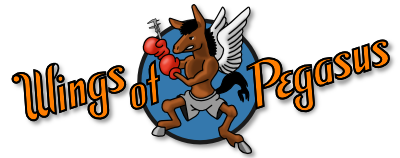
Junkers Ju 87 B-1 Stuka Airfix 1/72
 |
|
|
 I glued main parts without thinking. |
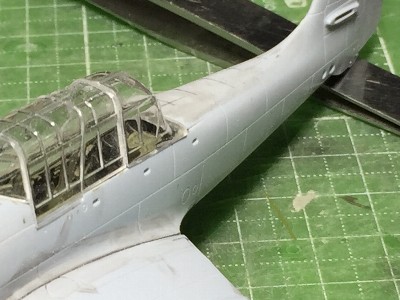 Then I checked the outline shape. The cross section of the rear fuselage was somewhat squarish. |
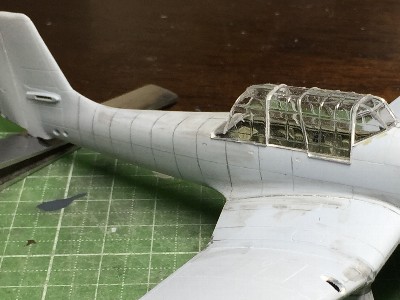 Edges of the rear fuselage were sanded. Note pencil lines. |
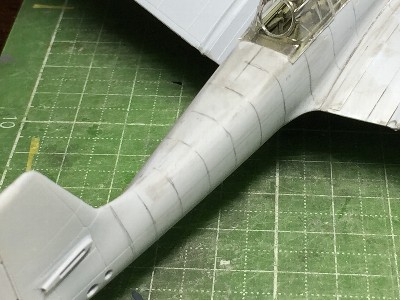 The lower portions of the fin and cockpit side were sanded as well. |
|
|
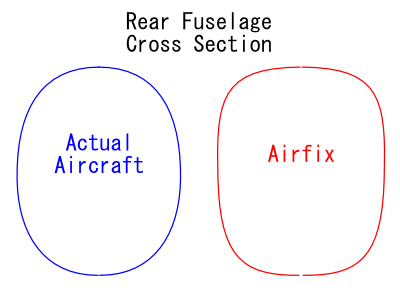 |
|
|
 These portions were corrected. This picture is "before correction". |
 The brown portions were sanded. This picture is "before correction". |
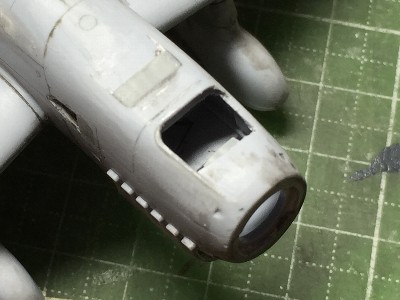 The front deck was cut out and glued again to reduce the position by 1mm (.04"). Then the opening of the oil-cooler was widened downward. |
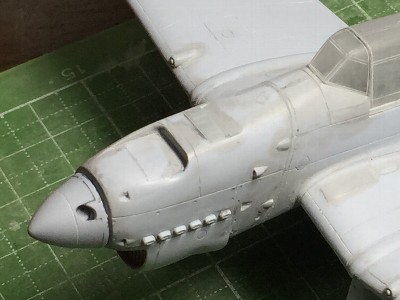 After correction. |
|
All surfaces of the kit were sanded and all panel lines were re-engraved with Tamiya 0.15mm (.006") thick photo-etching saw or a needle.
|
 The wood mold was made of chemical wood. |
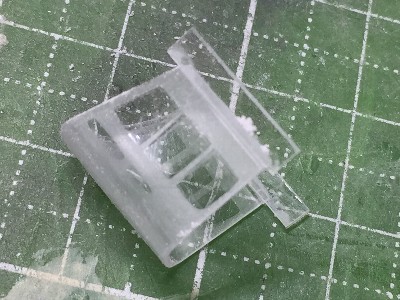 Other canopy parts were from the kit. Frames were sanded. 0.2mm (.008") clear plastic sheet was glued on the lower inside edge of the pilot slide food. |
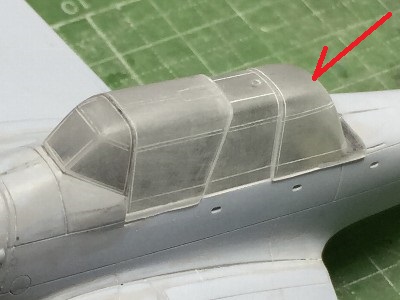 Canopy frames were engraved with handmade double needles. Inside and outside surfaces were sanded with #800 to #1500 sandpaper. The rear corner of kit canopy was a little squarish. But I didn't correct it. |
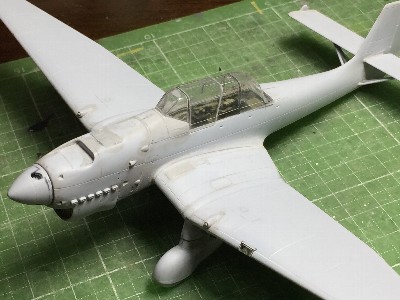 Then the canopy was polished with rubbing compound. |
|
|
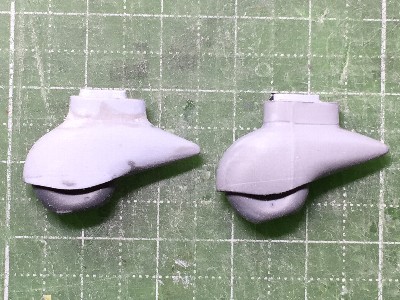 The left is corrected spat. The upper portion was cut and moved forward by 1mm. The right is kit original spat. |
 This set back gear spat brought a goony atmosphere of B-1. |
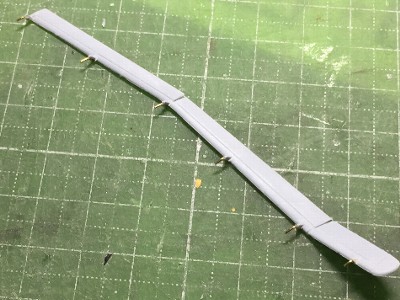 The flap and aileron was connected to the wing with 0.4mm (.015") brass rod. |
 The border of flap and aileron was half cut. Then the flap was downed. |
 The actuation rod and mass balance were brass rod. The tip of the mass was CA glue and plastic powder. |
 The seat harness was from FineMolds' Nano Aviation Series. The mesh of the gunner seat was cut out with knife. |
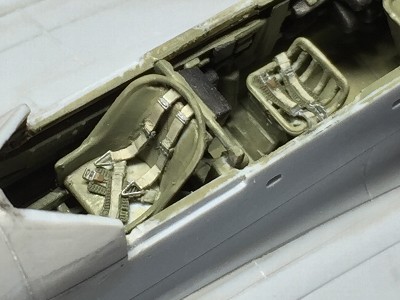 They were painted and glued. Oops, I mistook the position of pilot waist harness! Mmm... Forget it. |
 The instrument panel was kit decals. It was dry-brushed with dark gray and toned down. |
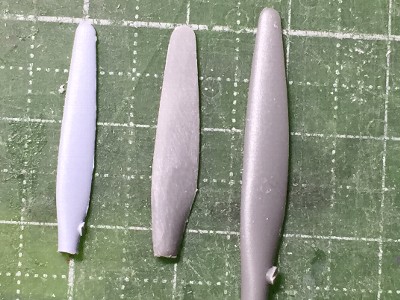 Kit propeller blade was rather poor. I used Airfix's 1/48(!) P-40B which was unsuitable for P-40B of its own. The left is kit original. The right is 1/48 P-40B original blade. The center is revised P-40B blade. |
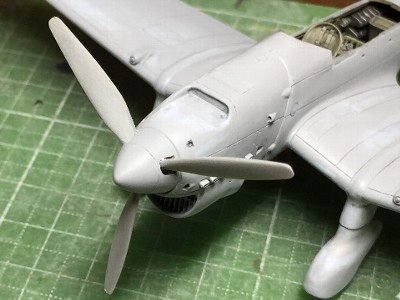 The root of the VDM blade installed on B-1 model is wide. So the kit spinner hole was enlarged. |
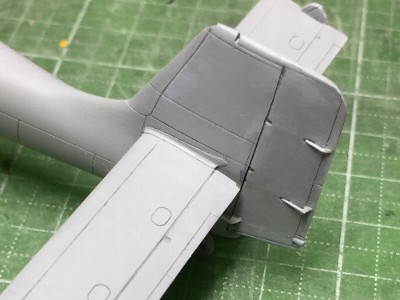 Actuate rod were made of extended sprue and plastic sheet. |
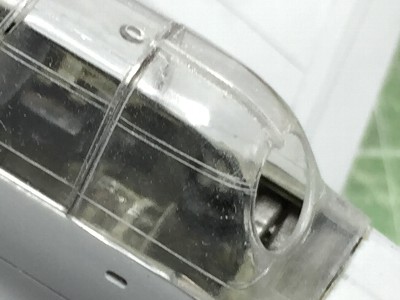 The fringe of the rear canopy top frame was made of 0.2mm (.008") clear plastic sheet. It was glued with thin liquid cement. |
 Then I could go to next painting stage. |
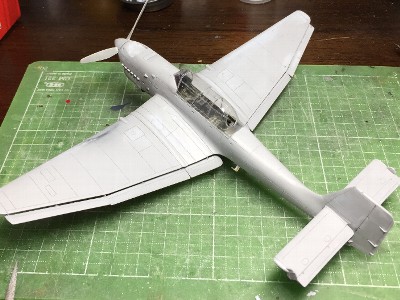 |
|
Some references described that the shark mouth was painted in BoB, but I think it has a low possibility. As for the period of Invasion of Poland, I cannot deny the possibility, but it is not sure. Thus I selected the period photos were taken. The manufacture code was VK+ER which was researched by NG Decals. NG Decals also described that the upper camouflage was repainted in a single RLM 70 Black Green. But I estimated it was still 70/71 standard scheme. This aircraft was oversprayed on the upper and lower demarcation line with 70 or 70/71.
|
 Mr.Surfacer was sprayed and the model surface was polished Mr.Laplos #6000. Then RLM 65 was sprayed. |
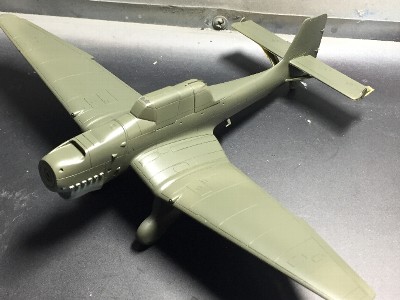 The next was RLM 71. |
 It was masked for RLM 70. |
 After 70 and 71 were painted, the demarcation line was masked and sprayed with RLM 65. |
 Some references described incorrect paint scheme demarcation lines. These red arrows are correct lines. |
 |
|
|
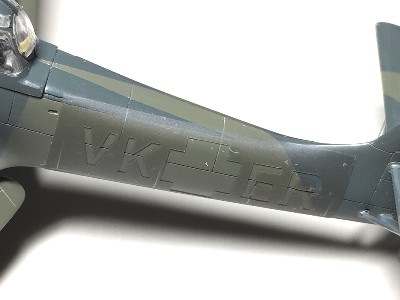 Oramask 810 Cutting Sheet was cut with a home use cutting machine. |
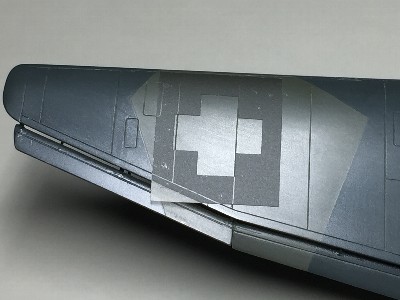 The size and position looked like as this pic for me. |
 The lower wing was like this. At first, unnecessary parts were pasted for positioning. |
 The position of this insignia was a supposition. This position was a majority of early B model. |
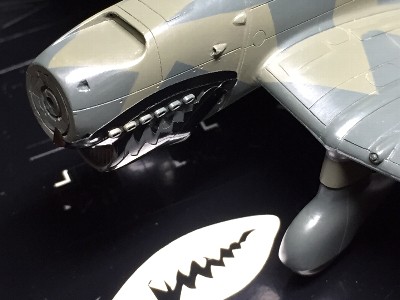 The shark mouth was masked with another cutting film which was more elasticized. |
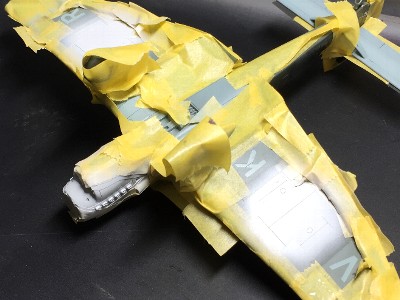 First, White for teeth and lower Balkenkreuz was sprayed. |
 Teeth were masked. |
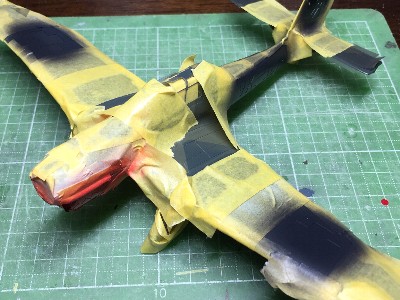 Mr. #114 RLM23 was painted. Black for markings was a mixture of 80% black and 20% white. This is the scale effects which cannot be gotten by decals. |
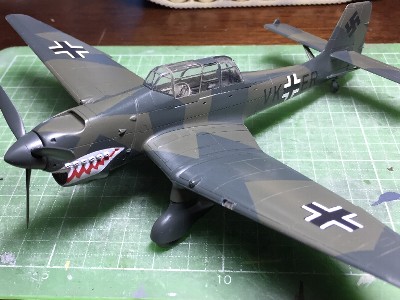 Painting works were finished. White of the upper wing and fuselage Balkenkreuz was also painted over Black. |
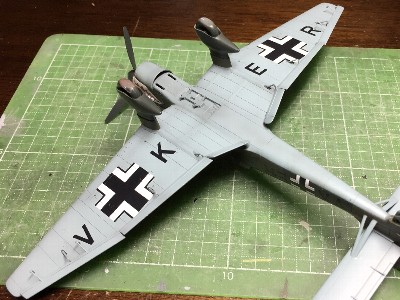 The lower side was finished as well. |
|
|
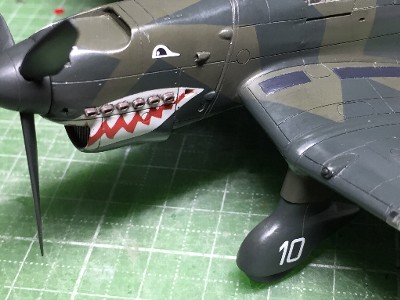 The shark eye (the white of the eye), nostril (? behind the propeller) and "10" were dry decals. The black of the eye had been painted in advance. |
 The white portion was dry decals on painted Black. |
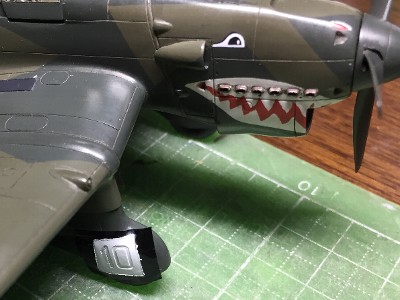 The starboard "10" dry decals was mistaken. So it was masked and painted. Data of cutting machine was the same as dry decals order. |
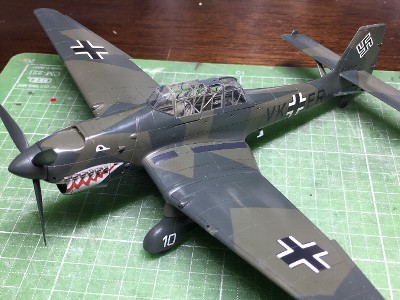 Flat clear was oversprayed for fixing and coating of dry decals. Then the surface was polished with Mr.Laplos. |
|
|
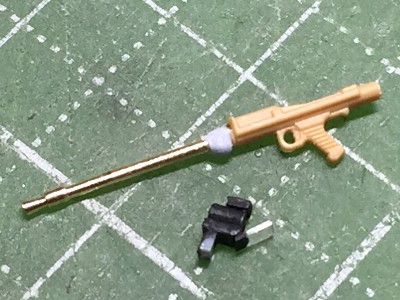 The machine gun barrel was made by hand router lathing of 0.8mm (.03") brass rod. Well, it's not so sharp. But, it just matches for Airfix's molds, doesn't it? |
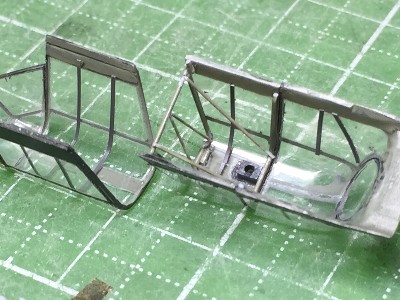 Inner frames of the canopy were gray cutting sheet. It was stuck on the inside. Some reinforce rods were made of extended sprue. |
 The canopy was glued. Chippings of Neutral Gray were painted with a fine brush. |
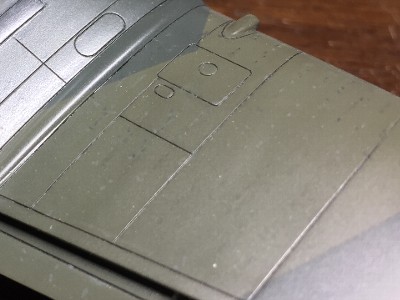 Chippings were painted along rivet lines. |
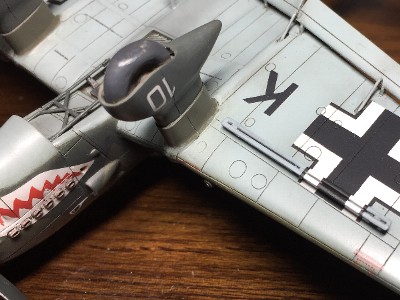 Kit decals were applied on the dive brake. Some caution markings were kit decals as well. |
 As for the lower side of stab stay bars, the majority might be RLM 65. But some aircraft were painted dark color. |
|
|
 |
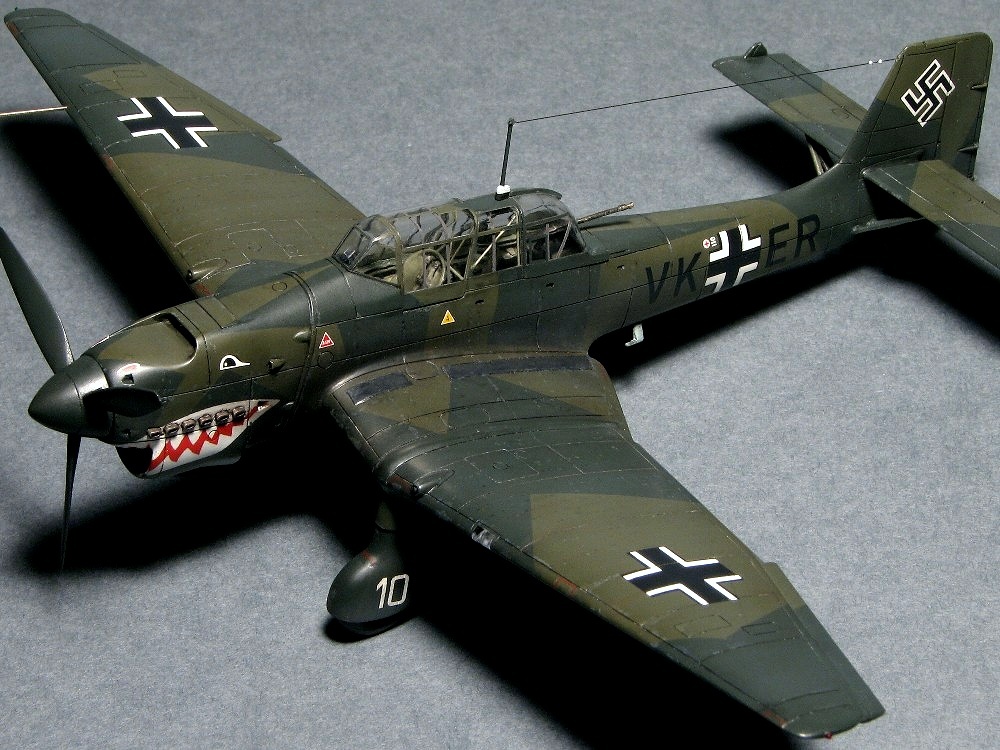 |
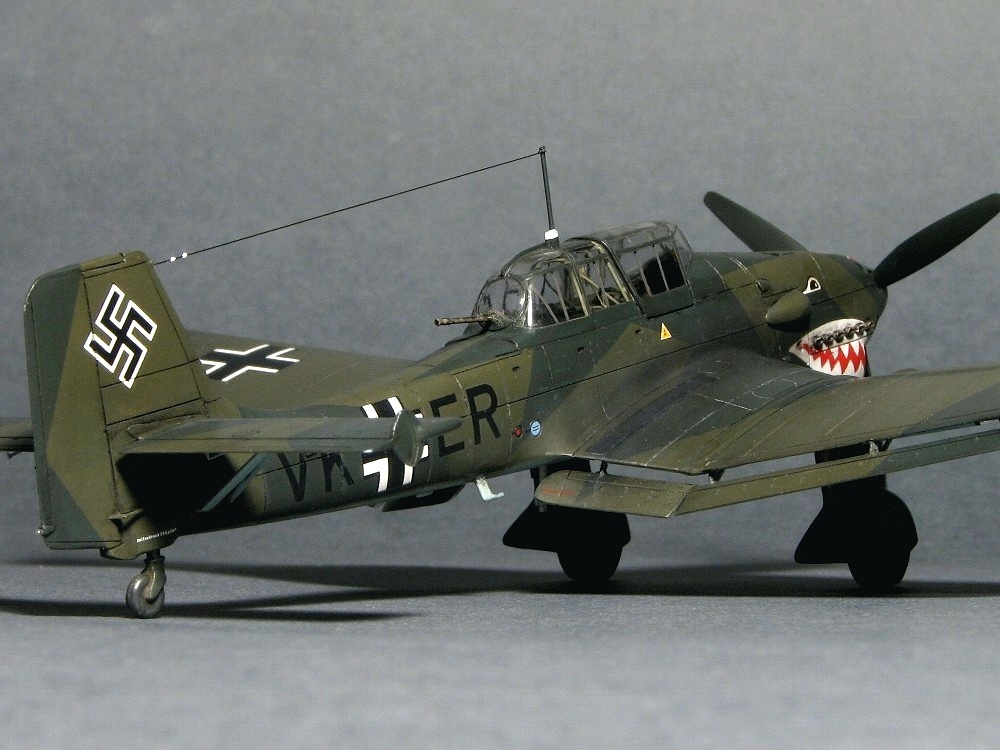 |
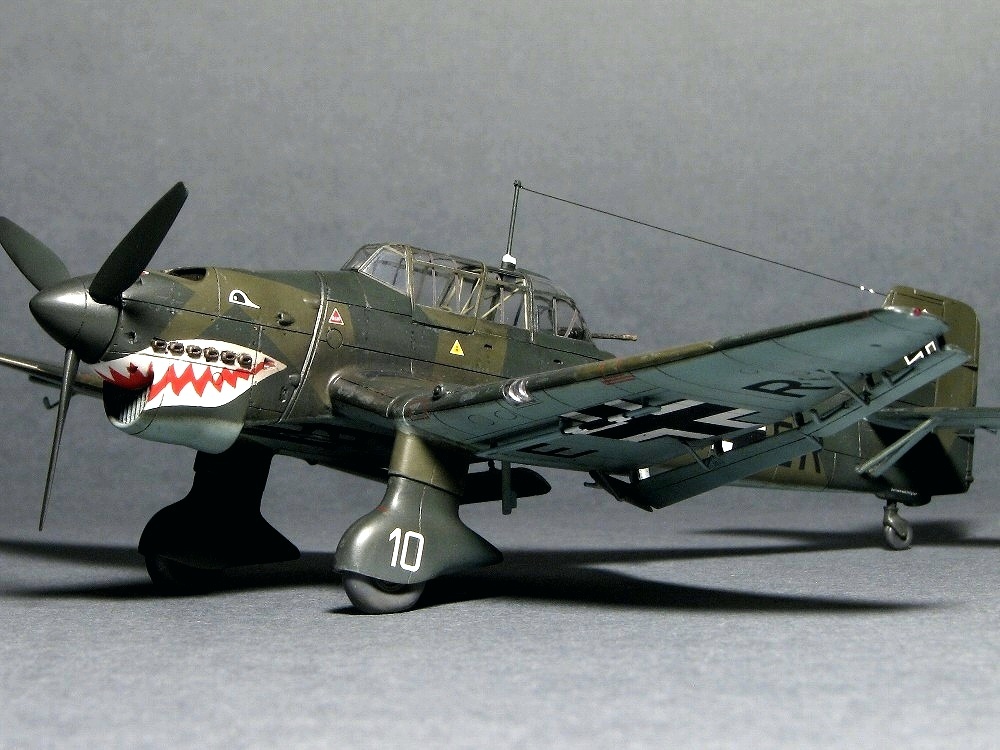 |
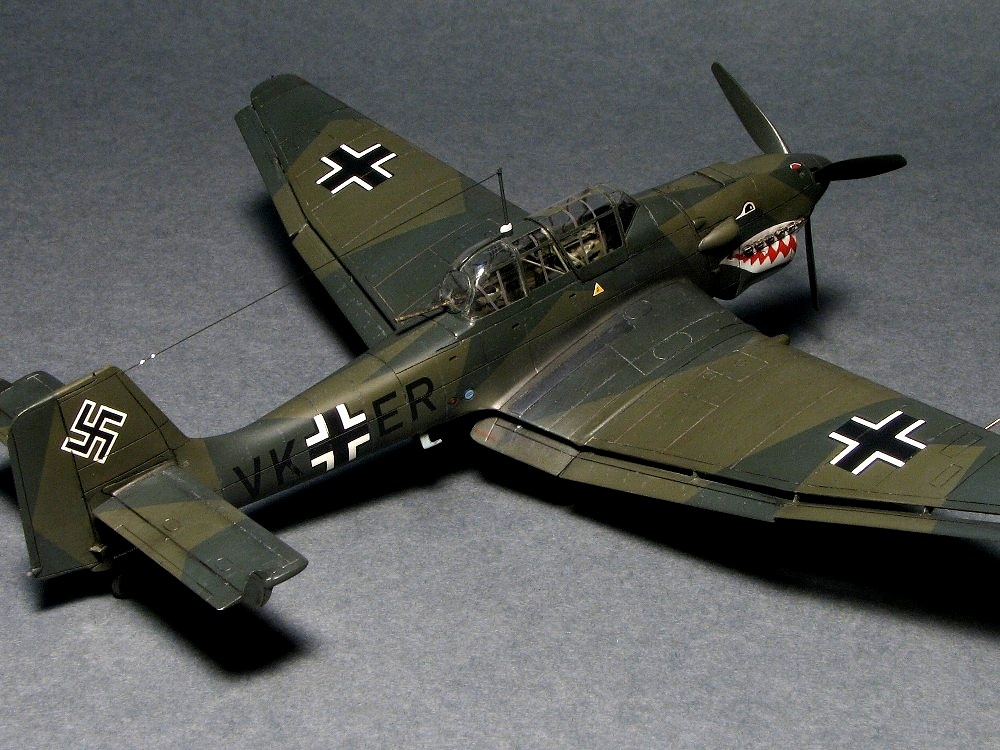 |
|
|
| 1 | Famous Airplanes Of The World No.11 Junkers Ju87 Stuka | 4-89319-008-3 | Bunrin Do |
| 2 | Famous Airplanes Of The World No.152 Junkers Ju87 Stuka | 4-89319-212-4 | Bunrin Do |
| 3 | Famous Airplanes Of The World (old edition) Ju 87 Stuka | - | Bunrin Do |
| 4 | Aero Detail No.11 Junkers Ju87 D/G | 4-499-22634-1 | Dai Nippon Kaiga |
| 5 | Ju 87 Stuka In Action aircraft no.73 | 0-89747-175-X | Squadron/Signal Publications |
| 6 | Combat Aircraft 1 Junkers Ju 87 Stukageschwader 1937-41 | 1-85532-818-6 | Osprey Publishing |
| 7 | Combat Aircraft 6 Junkers Ju 87 In North Africa And The Mediterranean | 1-85532-722-8 | Osprey Publishing |
| 8 | Combat Aircraft 74 Junkers Ju 87 Stukageschwader of the Russian Front | 978-1-84603-308-7 | Osprey Publishing |
| 9 | Air Vanguard 15 Junkers Ju 87 Stuka | 978-1-4728-0120-3 | Osprey Publishing |
| 10 | Warpaint 3 Junkers Ju-87 Stuka | - | Hall Park Books |
| 11 | Ju 87 Stuka Volume One: Luftwaffe Ju 87 Dive-Bomber Units 1939-1941 | 978-1-903223-69-7 | Classic Publications |
| 12 | Stuka Volume Two: Luftwaffe Ju 87 Dive-Bomber Units 1942-1945 | 978-1-903223-70-3 | Classic Publications |
| 13 | Junkers Ju 87 Stuka | 1-86126-177-2 | Crowood |
| 14 | Luftwaffe at War 7 Stuka Spearhead The Lightning War from Poland to Dunkirk, 1939-1940 | 1-85367-329-3 | Greenhill Books |
| 15 | Luftwaffe at War 9 Stukas Over The Steppe The Blitzkreig in the East, 1941-1945 | 1-85367-355-2 | Greenhill Books |
| 16 | Luftwaffe at war 11 Stukas over the Mediterranean 1940-45 | 1-85367-376-5 | Greenhill Books |
| 17 | The Luftwaffe Profile Series No.5 Junkers Ju 87A | 0-88740-920-2 | Schiffer Publishing |
| 18 | Military History vol.77 Ju 87 Stuka | 0-88740-477-4 | Schiffer Publishing |
| 19 | Monografie Lotnicze 19 Ju 87 Stuka | 83-86208-22-8 | AJ-Press |
| 20 | Monografie 25 Junkers Ju 87 vol.1 | 83-60445-08-7 | Kagero Studio |
| 21 | Flugzeug Profile 8 Junkers Ju 87A Stuka | - | Flugzeug Publikations |
| 22 | ADC 005 Junkers Ju 87 Part 1 The Early Variants A,B,C and R of the Luftwaffe Dive Bomber | 3-935687-44-3 | AirDOC |
| 23 | ADC 009 Junkers Ju 87 Part 2 The D-Variant of the Luftwaffe Dive Bomber | 3-935687-48-5 | AirDOC |
| 24 | Ali Straniere in Italia 2 Gli Stuka Della Regia | - | La Bancarella Aeronautica |
| 25 | On Target Special 9 The Battle of Britain Camouflage & Markings 1940 | 97-81904-643364 | The Aviation Workshop Publications |